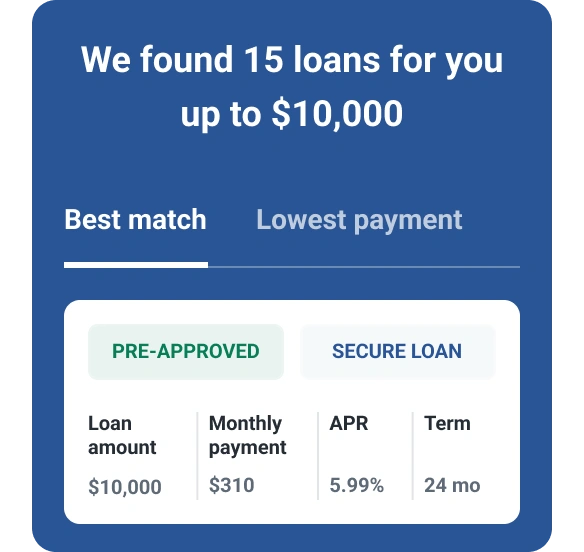How Do I Get a Subprime Loan?
Quick Answer
If you have less-than-stellar credit, you can get a subprime loan through lenders that offer products geared toward subprime borrowers. Keep in mind, subprime loans typically come with higher interest rates and longer repayment terms.

If you have less-than-ideal credit, you're not alone. Nearly 1 in 3 consumers have a subprime credit score (FICO® ScoresΘ below 670), but fortunately, this group has dropped by 12% since 2020.
Since subprime borrowers may find it hard to qualify for traditional loans, many lenders offer subprime loans that are geared toward borrowers with below-average credit scores. You can get a subprime loan in much the same way you would get any other loan: Submit a loan application and provide your lender with supporting documentation that demonstrates you can manage the payments.
Here's what you need to know about subprime loans and the steps you can take to get a subprime loan.
How Do Subprime Loans Work?
Subprime lenders typically require larger down payments on purchases than they require on conventional loans. For instance, a borrower with strong credit who qualifies for a conventional car loan might have to pay 5% of the purchase price in the form of a down payment, but a subprime borrower might need to put down 10% or more.
Additionally, the costs you'll pay over the life of a subprime loan are substantially higher than what you'd pay on a conventional loan for the same amount. Some of the factors which make subprime loans more costly include:
- Higher interest rates: You can expect the annual percentage rate (APR) on a subprime loan to be several points higher than it would be on a conventional loan. On a car loan, that can represent thousands of extra dollars over the life of the loan; on a mortgage, it can mean tens of thousands of dollars.
- Adjustable interest rates: Subprime loans, and particularly mortgage loans, often come with adjustable interest rates. Unlike fixed-rate loans where the interest rate and monthly payment remain the same, adjustable-rate loans can increase over the course of the repayment period.
- Higher fees: Origination fees with subprime loans are typically higher than you'd pay on a conventional loan. Origination fees are the upfront service charges you pay the lender for handling the loan. Late payment fees are likely to be steeper with subprime loans as well.
- Longer repayment periods: Subprime lenders may insist on extended-term loans that require more years to repay than similar conventional loans. Remember, the longer the repayment term, the more you'll likely pay in interest overall on a loan that already carries a steep interest rate.
How to Get a Subprime Loan
Ideally, your credit is strong enough to qualify you for a prime loan with a better interest rate and term. But if your credit score is below-average, you might consider getting a subprime loan. Here's how:
1. Review Your Credit Report and Credit Score
Your credit score is one of the leading factors in determining the type and terms of any loan you apply for. To get a good idea of whether you may qualify for a subprime (or any other) loan, check your credit score and credit report.
If you're not applying for an emergency loan, it may make sense to take some time to improve your credit. With a higher credit score, you could potentially qualify for a prime loan with more favorable terms.
2. Apply for a Loan
The best way to find out what loans you qualify for is to start applying for them. As with most loans, lenders will evaluate your credit report and credit score in making their decision. Your lender may also ask you to provide proof of income and employment. If you want to get a subprime mortgage loan, you may also need to provide banking and investment statements.
If you have poor credit or no credit at all and want to get a loan without a credit check, ask banks and other lenders if they will consider alternative data, such as proof of income and employment verification, instead of a credit inquiry.
3. Compare Multiple Lenders
A good place to start looking for any loan is with the financial institution that handles your checking and savings accounts. Banks and credit unions may have a little more leeway to work with established customers than with other subprime borrowers.
Whichever type of loan you seek, shop around and compare estimates from at least three or four lenders to find the best loan for your needs. If you're seeking an auto loan or a personal loan, online tools from Experian can use your credit score to help you find lenders willing to work with you. Many mortgage lenders also provide online application tools.
4. Make a Decision
After shopping around with multiple lenders to find the best loan rate, repayment term and fees, choose the loan offer that best suits your needs.
Even if you're prequalified for loans, you still need to complete a full application and submit any required documentation like pay stubs or tax returns. Once approved, you'll need to sign for the loan to receive the funding.
Can Subprime Loans Hurt Your Credit?
A subprime loan, by itself, can't hurt your credit. It's how you manage your subprime loan that matters.
As with any loan, making your loan payments by the due date each month can positively affect your credit score, while late or missing payments can damage your score. Even one late payment could negatively impact your credit score and make it more difficult to get loans or credit cards in the future.
Whenever you take out a new loan, subprime or otherwise, your credit score may dip temporarily until you demonstrate you can manage your loan successfully with timely payments.
Also, applying for any credit product typically triggers a hard inquiry on your credit report, which can briefly drop your score up to five points. Fortunately, credit scoring models understand when you're shopping for the best rate and will generally count multiple inquiries as a single inquiry if they happen within a short time frame.
How to Improve a Subprime Credit Score
Subprime loans may be your only option if you're new to credit or your credit score isn't ideal. To qualify for loans with more attractive interest rates and terms, you may want to take steps to improve your credit, such as:
- Make on-time payments. Paying your credit payments by the due date is critical because your payment history accounts for 35% of your FICO® Score.
- Pay down your credit card balances. Your credit utilization rate—the percentage of your credit limits you're using—makes up 30% of your credit score. The lower you can get your balances, the better.
- Check your credit reports. Inaccurate entries on your credit report may be hurting your credit score. Review your credit reports for discrepancies and dispute inaccuracies to the relevant credit bureau to correct them. You can get a free copy of your Experian credit report or request reports from each of the three national credit bureaus (Experian, TransUnion and Equifax) at AnnualCreditReport.com.
- Catch up on overdue accounts. Work to get current on any past-due accounts or collection accounts as soon as possible. Doing so will prevent further late payment marks to your credit history, and being current on your accounts could be good for your credit.
- Sign up for Experian Boost®ø. Enrolling in Experian Boost can improve your FICO® Score from Experian by giving you credit for paying your phone, utility and streaming bills on time.
The Bottom Line
The primary benefit of subprime loans is that they allow borrowers with limited or bad credit to finance a home, car or other purchases. But, you'll likely pay a higher interest rate over a longer repayment term than with a conventional loan.
If you must get a subprime loan, make your payments on time each month to build a positive credit history over time. Track your progress using Experian's free credit monitoring service and receive alerts of any changes with an updated monthly report so you can stay on top of any changes.
Need a personal loan?
Whether you're looking to eliminate debt or access cash fast, compare personal loan offers matched to your credit profile.
Start now for freeAbout the author
Tim Maxwell is a former television news journalist turned personal finance writer and credit card expert with over two decades of media experience. His work has been published in Bankrate, Fox Business, Washington Post, USA Today, The Balance, MarketWatch and others. He is also the founder of the personal finance website Incomist.
Read more from Tim

